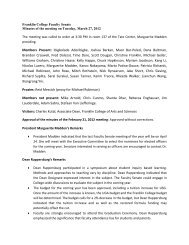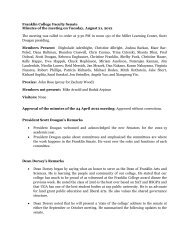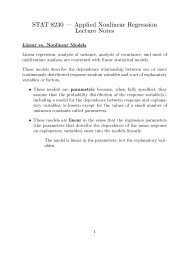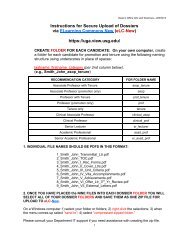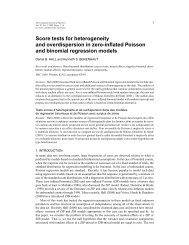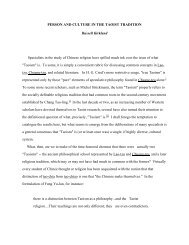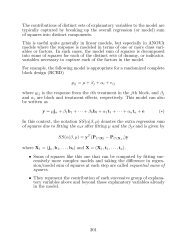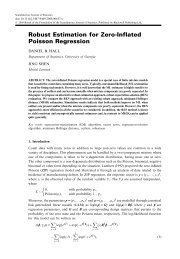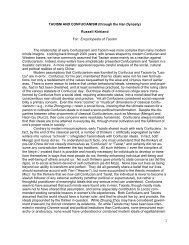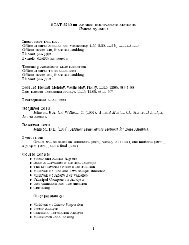Two-component mixtures of generalized linear mixed effects models ...
Two-component mixtures of generalized linear mixed effects models ...
Two-component mixtures of generalized linear mixed effects models ...
You also want an ePaper? Increase the reach of your titles
YUMPU automatically turns print PDFs into web optimized ePapers that Google loves.
24 DB Hall and L Wang<br />
The model form given by Equation (2.1) is quite flexible, allowing a wide variety <strong>of</strong><br />
random <strong>effects</strong> specifications. For example, a model with random cluster specific<br />
intercepts might assume Z 1ij ¼ x T ij a þ y 1b 1i and Z 2ij ¼ z T ij b þ y 2b 2i . This implies independent<br />
cluster <strong>effects</strong> in the two <strong>component</strong>s. Correlated <strong>component</strong>s can be induced<br />
by assuming Z 1ij ¼ x T ij a þ y 1b 1i and Z 2ij ¼ z T ij b þ y 2b 2i þ y 3 b 1i , which leads to<br />
qffiffiffiffiffiffiffiffiffiffiffiffiffiffiffi<br />
corr(Z 1ij ; Z 2iij ) ¼ y 3 = y 2 2 þ y 2 3. The form given by Equation (2.1) simply generalizes<br />
these cases to higher dimension, allowing random slope and intercept <strong>models</strong> and other<br />
more general random <strong>effects</strong> structures. An alternative approach would have been to<br />
allow correlated random <strong>effects</strong> b ~ 1i ; b ~ 2i , say, where b ~ ki appears only in the kth <strong>linear</strong><br />
predictor and cov( b ~ 1i ; b ~ 2i ) 6¼ 0. However, this more straight forward approach, which is<br />
essentially a reparametrization <strong>of</strong> the model we focus on, is not as conducive to<br />
estimation via the EM algorithm because it leads to a complete data likelihood, which<br />
does not factor cleanly into terms for each <strong>component</strong> in the mixture. [In particular, the<br />
second and third terms <strong>of</strong> formula (3.3) defined subsequently, which is the expected<br />
complete data loglikelihood used in the EM algorithm, would share parameters<br />
pertaining to corr( b ~ 1i ; b ~ 2i ).]<br />
Note that in Equation (2.1) we have assumed canonical links, but this is not<br />
necessary. In general, we allow known links g 1 and g 2 so that m 1ij ¼ g1 1(Z<br />
1ij ) and<br />
m 2ij ¼ g2 1(Z<br />
2ij ). Furthermore, we assume that the mixing mechanisms for each observation<br />
are independent, with probabilities p i ¼ (p i1 ; ...; p ini ) T , i ¼ 1; ...; C, each following<br />
a regression model <strong>of</strong> the form g p (p i ) ¼ W i c, involving a known link function g p ,<br />
unknown regression parameter c and n i s design matrix W i . Typically, g p will be<br />
taken to be the logit link, but the probit, complementary log–log, or other link function<br />
can be chosen here.<br />
Let ~a ¼ (a T ; h T 1) T and b ~ ¼ (b T ; h T 2; h T 3) T , and denote the combined vector <strong>of</strong> model<br />
parameters as d ¼ (~a T ; b ~ T ; c T ; s 1 ; s 2 ) T . The loglikelihood for d based on y is given by<br />
‘(d; y) ¼ XC<br />
i¼1<br />
( ð )<br />
Y n i<br />
log f (y ij jb i ; d)f q (b i )db i<br />
j¼1<br />
where f (y ij jb i ; d) ¼ {p ij (c)}f 1 (y ij jb i ; ~a; s 1 ) {1 p ij (c)}f 2 (y ij jb i ; ~ b; s 2 ), f q ( ) denotes the<br />
q-dimensional standard normal density function, and the integral is q-dimensional.<br />
3 Fitting the two-<strong>component</strong> mixture model via the EM algorithm<br />
The complications <strong>of</strong> parameter estimation in mixture <strong>models</strong> are simplified considerably<br />
by applying the EM algorithm. Let u ij , i ¼ 1; ...; C, j ¼ 1; ...; n i denote the<br />
<strong>component</strong> membership; u ij equals one if Y ij is drawn from distribution F 1 and equals<br />
zero if Y ij is drawn from F 2 . Then the ‘complete’ data for the EM algorithm are (y, u, b).<br />
Here, (u, b) play the role <strong>of</strong> missing data, where u ¼ (u 11 ; ; u CnC ) T . On the basis <strong>of</strong>



